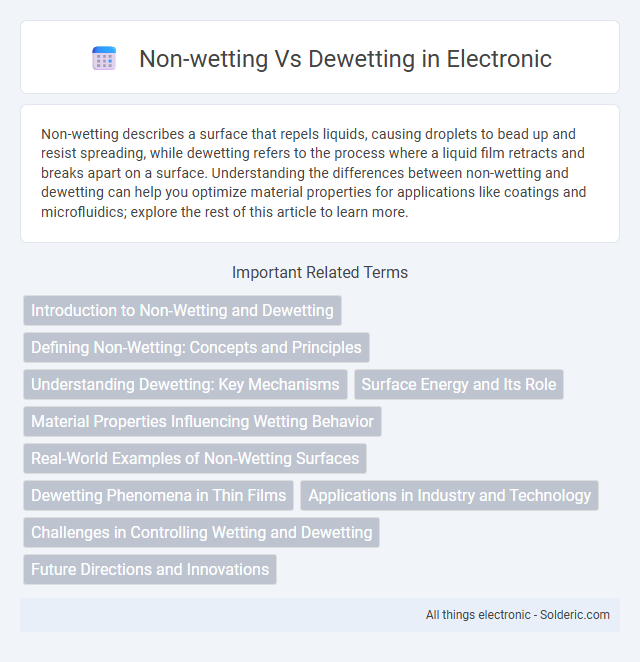Non-wetting describes a surface that repels liquids, causing droplets to bead up and resist spreading, while dewetting refers to the process where a liquid film retracts and breaks apart on a surface. Understanding the differences between non-wetting and dewetting can help you optimize material properties for applications like coatings and microfluidics; explore the rest of this article to learn more.
Comparison Table
| Feature | Non-Wetting | Dewetting |
|---|---|---|
| Definition | Surface resists liquid spreading; liquid forms droplets without spreading | Process where liquid retracts from a surface, often breaking into droplets |
| Contact Angle | High contact angle (>90deg) indicating poor wetting | Increasing contact angle over time due to liquid retraction |
| Surface Energy | Low surface energy causing liquid to bead up | Surface energy causes liquid film to break and contract into droplets |
| Mechanism | Inherent surface properties prevent liquid adhesion | Destabilization of liquid film resulting in receding liquid |
| Examples | Hydrophobic coatings, lotus leaf effect | Thin liquid films breaking into droplets on hydrophobic surfaces |
| Applications | Water-resistant textiles, anti-fouling surfaces | Control of liquid patterns in microfluidics, coating technologies |
Introduction to Non-Wetting and Dewetting
Non-wetting and dewetting describe surface interactions where liquids either repel from or retract on solid surfaces. Non-wetting occurs when a liquid forms droplets due to high contact angles on hydrophobic materials, minimizing surface adhesion. Dewetting involves the spontaneous retraction of a liquid film, often driven by surface energy imbalances, affecting processes like coating and liquid transport on your materials.
Defining Non-Wetting: Concepts and Principles
Non-wetting describes a surface condition where a liquid fails to spread, maintaining high contact angles typically greater than 90 degrees, due to unfavorable intermolecular interactions. This phenomenon arises from low surface energy materials or coatings that repel the liquid, preventing adhesion and promoting droplet formation. The underlying principles involve Young's equation, which balances surface tensions at the solid-liquid-gas interface to define wetting behavior.
Understanding Dewetting: Key Mechanisms
Dewetting occurs when a liquid retracts from a solid surface, driven by surface energy imbalances and interfacial tension differences. Key mechanisms include nucleation of dry spots, growth of these areas, and coalescence, influenced by surface roughness, chemical heterogeneity, and temperature. Understanding dewetting helps you control film stability in coatings, microfluidics, and material design applications.
Surface Energy and Its Role
Surface energy dictates the interaction between a liquid and solid surface, influencing whether a surface is non-wetting or undergoing dewetting. Non-wetting surfaces have low surface energy, causing liquids to form droplets with high contact angles, minimizing adhesion. Dewetting occurs when a liquid film retracts from a substrate due to unfavorable surface energy balance, leading to liquid segmentation and exposure of the underlying surface.
Material Properties Influencing Wetting Behavior
Surface energy, roughness, and chemical composition critically influence wetting behavior, determining whether a material exhibits non-wetting or dewetting characteristics. Hydrophobic materials with low surface energy repel liquids, leading to non-wetting surfaces, while hydrophilic materials with high surface energy enhance dewetting by allowing water to spread or retract easily. Your material's molecular structure and surface treatment directly affect liquid adhesion and contact angle, optimizing performance for applications like coatings and textiles.
Real-World Examples of Non-Wetting Surfaces
Non-wetting surfaces repel liquids, preventing water or oil from spreading, commonly seen in lotus leaves, which exhibit superhydrophobicity to stay clean and dry. Your smartphone screens often use oleophobic coatings to resist fingerprint oils, enhancing usability and durability. Non-wetting properties also play critical roles in industrial applications such as anti-corrosion coatings and self-cleaning solar panels, improving performance and lifespan.
Dewetting Phenomena in Thin Films
Dewetting phenomena in thin films occur when a liquid film retracts from a substrate due to unfavorable surface energy interactions, resulting in the formation of droplets or dry patches. This process contrasts with non-wetting, where the liquid does not spread evenly, but remains more stable on the surface. Understanding dewetting is crucial for optimizing coatings, enhancing material performance, and controlling film stability in applications like microelectronics and biomedical devices.
Applications in Industry and Technology
Non-wetting surfaces, characterized by high water contact angles, are integral in industries such as automotive coatings and waterproof textiles where liquid repellency enhances durability and performance. Dewetting phenomena are leveraged in microelectronics and printing technologies to control fluid movement and prevent defects during manufacturing processes. Understanding the balance between non-wetting and dewetting properties allows you to optimize surface treatments for improved efficiency in applications ranging from anti-fouling coatings to lab-on-chip devices.
Challenges in Controlling Wetting and Dewetting
Controlling wetting and dewetting presents challenges due to the complex interplay of surface energy, material roughness, and environmental conditions that influence liquid behavior on surfaces. Non-wetting surfaces repel liquids, requiring precise manipulation of surface chemistry and texture to maintain stability under dynamic conditions such as temperature fluctuations or mechanical stress. Your ability to engineer surfaces with tailored wettability depends on overcoming these factors to achieve consistent performance in applications like coatings, biomedical devices, and microfluidics.
Future Directions and Innovations
Future directions in non-wetting and dewetting technologies emphasize the development of smart surfaces with tunable wettability for applications in self-cleaning, anti-fouling, and efficient liquid transport systems. Innovations include responsive materials that switch between hydrophobic and hydrophilic states, leveraging stimuli such as temperature, light, or electric fields to control wetting behavior dynamically. Advances in nanofabrication and surface engineering enable precise manipulation of surface roughness and chemistry, enhancing the durability and functionality of non-wetting coatings in industrial and biomedical settings.
Non-wetting vs dewetting Infographic

 solderic.com
solderic.com